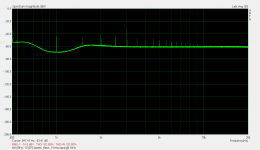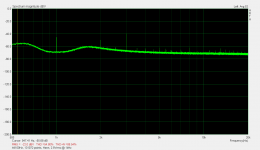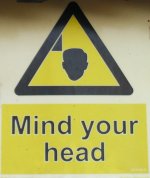Yes
Gee what a coincidence, the noise floor agrees again. Ref 2 is my oscillator Jeff was my tech and I wanted him to get the company publishing award (as small as it was). You see why I feel some ownership of this. We also were required to use our parts and get the caps from the stockroom. Subsequent fiddling got down to -130db with 1998 parts. I did do an unpublishable version that took several minutes to to settle even at 1K that was probably better.
yes, amazing isnt it?
here is a really really older osc design...... used in a HP-339A. I just changed opamps and a few parts. 2H = -140dBv
[I also changed and tweeked the analyzer section..... mil grade, ceramic et al for greater low level linearity. Could easily add a X10 gain for the meter.]
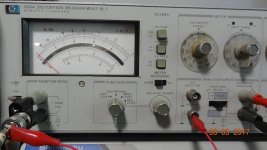
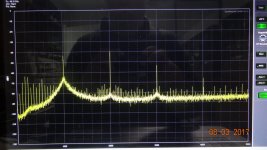
THx-RNMarsh
Last edited:
Scott,
do you have a link that works for the ref 2, the EDN link doesn't
thanks
Alan
OK, got it
http://www.edn.com/electronics-news/4351580/EDN--11-10-94-Oscillator-keeps-THD-below-1-ppm
do you have a link that works for the ref 2, the EDN link doesn't
thanks
Alan
OK, got it
http://www.edn.com/electronics-news/4351580/EDN--11-10-94-Oscillator-keeps-THD-below-1-ppm
Last edited:
Scott,
do you have a link that works for the ref 2, the EDN link doesn't
thanks
Alan
OK, got it
EDN -- 11.10.94 Oscillator keeps THD below 1 ppm | EDN
You can thank Paul Rako, now semi-retired, for getting this stuff back up. 1994 that's older than I remember.
yes, amazing isnt it?
Well no, you still show a ridiculously low noise floor. Can someone find out what the QA401 device is doing, synchronous averaging, etc.
EDIT downloaded it, manual shows nothing in fact usual fairly low featured audio specific stuff. Software won't read in .wavs, etc. so I can't run a test.
Last edited:
Well no, you still show a ridiculously low noise floor. Can someone find out what the QA401 device is doing, synchronous averaging, etc.
EDIT downloaded it, manual shows nothing in fact usual fairly low featured audio specific stuff. Software won't read in .wavs, etc. so I can't run a test.
i hope you get an answer to your question re noise floor. maybe a call to them?
Harmonic data is same regardless --- using AP or Panasonic or Spectrum analyzer.
Will be interesting to know what they tell you. Maybe they can straighten this out for us.
-RNM
Last edited:
Maybe they can straighten this out for us.
-RNM
Nice lab there BTW 2nV of 60Hz hum.
Yes, I worked out a very clean test system... Here is a straight-ahead measurement... no QA401 FFT/noise suppression..... just read off the meter.
It is on -110 dBv FS. Or -130db at the -20db mark to the left.... as you can see, the THD of all harmonics and junk freq shows THD to be below the -130db mark... around maybe -135dB
And then factor in the +6db because input is not 1 volt but 2 volts. Right there we are at -140 or better.
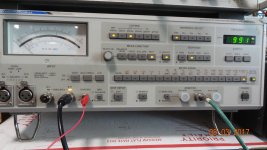
THx-RNMarsh
It is on -110 dBv FS. Or -130db at the -20db mark to the left.... as you can see, the THD of all harmonics and junk freq shows THD to be below the -130db mark... around maybe -135dB
And then factor in the +6db because input is not 1 volt but 2 volts. Right there we are at -140 or better.

THx-RNMarsh
Last edited:
That was subtle.
not really. But just as long as it doesnt go below the -130dB line..... the noise floor of the monitor output, then we would have real issues.
-RNM
Scot and Richard,
Here is the scoop on the Shibasoku 725D.
Pic #1 is a 1Vrms input to the 725D. The second harmonic agrees with the passive twin T
measurement -141.7dBV 2nd harmonic. At 1Vrms input the input is at unity with the 1Vrms FS of the monitor output.
Pic #2 the input has been increased to 2.5Vrms. This level put the 725D into the next higher input range 3Vrms (+10dB). Notice the harmonics drop about 10dB and so does the noise. This is not correct. In the + 10dB input range the monitor port scale is 10dB less or there about. We no longer have unity scaling. This is the discrepancy.
The Shibasoku 725D measures ratio of fundamental to noise and distortion and displays this accurately on the meter. The scaling is such that the meter reading is correct. The monitor output is not intended for accurate measurement. If we are going to use it this way then we need to compensate for the difference from unity.
The FFT settings are stated at the bottom of the ARTA plots.
Here is the scoop on the Shibasoku 725D.
Pic #1 is a 1Vrms input to the 725D. The second harmonic agrees with the passive twin T
measurement -141.7dBV 2nd harmonic. At 1Vrms input the input is at unity with the 1Vrms FS of the monitor output.
Pic #2 the input has been increased to 2.5Vrms. This level put the 725D into the next higher input range 3Vrms (+10dB). Notice the harmonics drop about 10dB and so does the noise. This is not correct. In the + 10dB input range the monitor port scale is 10dB less or there about. We no longer have unity scaling. This is the discrepancy.
The Shibasoku 725D measures ratio of fundamental to noise and distortion and displays this accurately on the meter. The scaling is such that the meter reading is correct. The monitor output is not intended for accurate measurement. If we are going to use it this way then we need to compensate for the difference from unity.
The FFT settings are stated at the bottom of the ARTA plots.
Attachments
Last edited:
Scot and Richard,
Here is the scoop on the Shibasoku 725D.
Pic #2 the input has been increased to 2.5Vrms. This level put the 725D into the next higher input range 3Vrms (+10dB). Notice the harmonics drop about 10dB and so does the noise. This is not correct. In the + 10dB input range the monitor port scale is 10dB less or there about. We no longer have unity scaling. This is the discrepancy.
The Shibasoku 725D measures ratio of fundamental to noise and distortion and displays this accurately on the meter. The scaling is such that the meter reading is correct. The monitor output is not intended for accurate measurement. If we are going to use it this way then we need to compensate for the difference from unity.
The FFT settings are stated at the bottom of the ARTA plots.
yes. This all correct from my view also. The 3v and above ranges are attenuators to get back to 1 volt. Below one volt range there is gain... again to keep things at one volt.
When I did my idle/calibration tone mix, i had the output just below 1 volt so I was on 1 volt range.
Otherwise, I compensate by adding 6db at the qA401 -via its software - so it reflects the higher voltage being tested.
I am getting about the same as you on my gen. Maybe 2-3dB better with my trim at 2.2v output.
Some error in difference is with the monitor Zo of 1K, and input Z of 10k or less from the QA401, a dB can be lost. I have changed the Zo from the monitor to 10 Ohms. less noise also.
So, with that in mind, we are only about 1 dB apart in the two generators.
THx-RNMarsh
Last edited:
Pic #2 the input has been increased to 2.5Vrms. This level put the 725D into the next higher input range 3Vrms (+10dB). Notice the harmonics drop about 10dB and so does the noise. This is not correct. In the + 10dB input range the monitor port scale is 10dB less or there about. We no longer have unity scaling. This is the discrepancy.
Thank you David, an auto scaling artifact as I supposed a few days ago the monitor output is not corrected since it's not intended as a primary output, all now is well. Good detective work.
When I did my cal tone test. I got exactly correct data because I know the instrument is optimised on the 1v range. I made a mixer for the two signals using two 2.2K each into a 1.1K across the 725D input.
Slightly less than 1 volt but on the 1v range.
THx-RNmarsh
Slightly less than 1 volt but on the 1v range.
THx-RNmarsh
I'm going to check this with the Shibasoku 725C. The 725C has always given me higher reading. I though it was more residual but maybe the scaling is different.
The 725D is a complete rework of the series. The boards have near twice the density of parts. The back plane is different and the connectors as well. It could be the gain structure was reworked. Looks like a different engineer did the 725D.
The 725D is a complete rework of the series. The boards have near twice the density of parts. The back plane is different and the connectors as well. It could be the gain structure was reworked. Looks like a different engineer did the 725D.
Richard it not amount down from FS that need to be corrected. It's amount above unity.
I Vrms is 0dBV. 2,5Vrms is near 8dBV. It's the 8dB that needs to be resolved.
2.2Vrms above unity is 6.85dB. Plus any other apparent offsets which could be from the QA401.
If 3Vrms is input then correction is for +10dB.
I Vrms is 0dBV. 2,5Vrms is near 8dBV. It's the 8dB that needs to be resolved.
2.2Vrms above unity is 6.85dB. Plus any other apparent offsets which could be from the QA401.
If 3Vrms is input then correction is for +10dB.
Nice lab there BTW 2nV of 60Hz hum.
Yeah, noted the same myself, some time ago: http://www.diyaudio.com/forums/equi...n-audio-range-oscillator-472.html#post4711710
Yeah, noted the same myself, some time ago: http://www.diyaudio.com/forums/equi...n-audio-range-oscillator-472.html#post4711710
Can't rush these things. Gives pulling teeth a new meaning. Do you thing we could get Dick into Pigface?
Attachments
Last edited:
Sorry, guys. I am just not interested enough to care. Maybe it is related to the 3 volt range vs 1 v range. But really, if you dont motivate me with something more than this-- I won't/dont care about it.
I am focused on a trip deep into the Peruvian Amazon rain forest/jungle adventure in 8 days. But I appreciate pointing out any potential inconsistencies for everyone out there reading this forum.
THx-RNMarsh
I am focused on a trip deep into the Peruvian Amazon rain forest/jungle adventure in 8 days. But I appreciate pointing out any potential inconsistencies for everyone out there reading this forum.
THx-RNMarsh
Last edited:
Do you thing we could get Dick into Pigface?
That's a scary thought, there's a small (but non zero) chance he will buy them out for personal use only. I'll pass.
Richard it not amount down from FS that need to be corrected. It's amount above unity.
I Vrms is 0dBV. 2,5Vrms is near 8dBV. It's the 8dB that needs to be resolved.
2.2Vrms above unity is 6.85dB. Plus any other apparent offsets which could be from the QA401.
If 3Vrms is input then correction is for +10dB.
Yes. I agree.
- Home
- Design & Build
- Equipment & Tools
- Low-distortion Audio-range Oscillator
